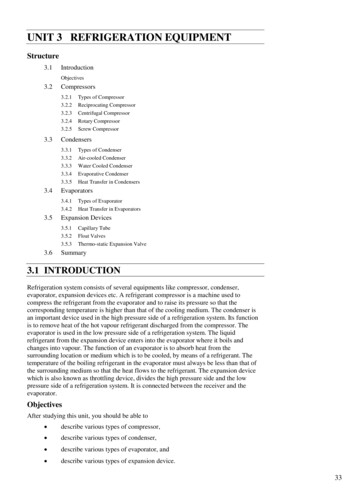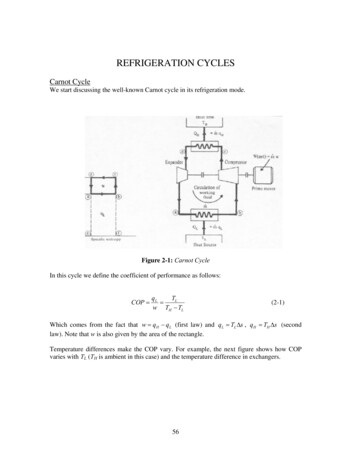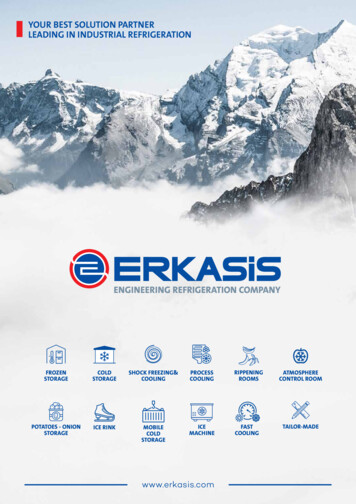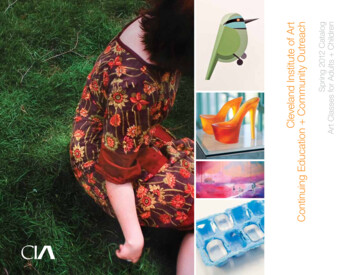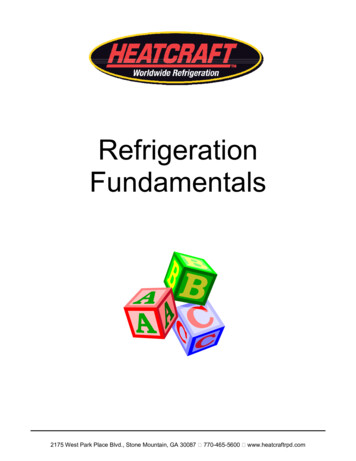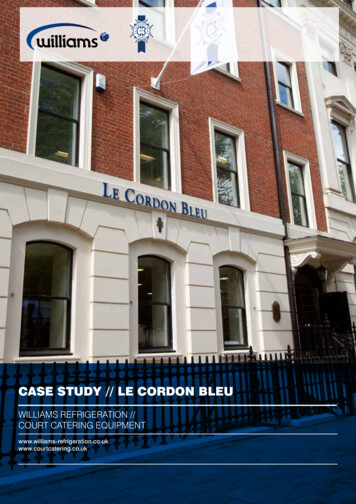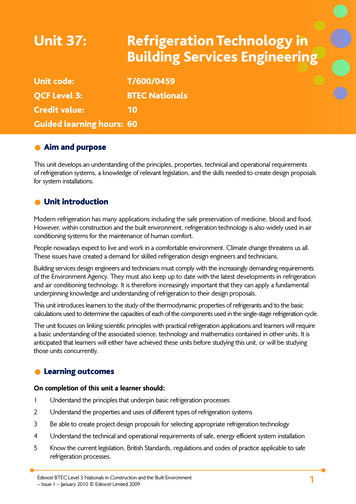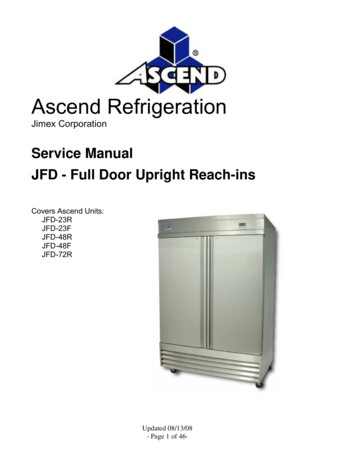
Transcription
Grades 9 to 12Refrigeration andAir ConditioningManitoba Technical-VocationalCurriculum Frameworkof Outcomes
Gr ades 9 to 12r efr iGer at ion and a irC o n d i t i o n i n G te C h n o l o G yManitoba Technical-Vocational CurriculumFramework of Outcomes2015Manitoba Education and Advanced Learning
Manitoba Education and Advanced Learning Cataloguing in Publication DataGrades 9 to 12 refrigeration and air conditioning technology :Manitoba technical-vocational curriculum frameworkof outcomesIncludes bibliographical references.ISBN: 978-0-7711-6190-2 (pdf)1. Heating and ventilation industry—Employees—Vocationalguidance.2. Refrigerator industry—Employees—Vocational guidance.3. Heating and ventilation industry—Study and teaching (Secondary)—Manitoba.4. Refrigerator industry—Study and teaching (Secondary)—Manitoba.5. Air conditioning—Equipment and supplies—Maintenance and repair—Study and teaching (Secondary)—Manitoba.6. Heating—Equipment and supplies—Maintenance and repair—Studyand teaching (Secondary)—Manitoba.7. Refrigeration and refrigerating machinery—Maintenance and repair—Study and teaching (Secondary)—Manitoba.8. Technical education—Manitoba—Curricula.9. Vocational education—Manitoba—Curricula.I. Manitoba. Manitoba Education and Advanced Learning.697.00712Copyright 2015, the Government of Manitoba, represented by the Minister ofEducation and Advanced Learning.Manitoba Education and Advanced LearningSchool Programs DivisionWinnipeg, Manitoba, CanadaEvery effort has been made to acknowledge original sources and to complywith copyright law. If cases are identified where this has not been done, pleasenotify Manitoba Education and Advanced Learning. Errors or omissions willbe corrected in a future edition. Sincere thanks to the authors, artists, andpublishers who allowed their original material to be used.Schools are encouraged to share this resource with parents, guardians, andcommunities, as appropriate.Any websites referenced in this resource are subject to change. Educatorsare advised to preview and evaluate websites and online resources beforerecommending them for student use.This resource is available on the Manitoba Education and AdvancedLearning website at www.edu.gov.mb.ca/k12/ .Available in alternate formats upon request.
Contents8997 Applied Refrigeration and Air ConditioningCurriculum Implementation Dates89Grades 9 to 11 Refrigeration and Air Conditioning:General and Specific Learning Outcomes by GoalAcknowledgementsvTechnical-Vocational Education Overview1Goal 1: Describe and apply appropriate healthand safety practices as they apply to refrigerationand air conditioning.13Refrigeration and Air Conditioning Overview1Goal 2: Demonstrate the safe and appropriateselection, operation, and management of shopequipment and tools.18Goal 3: Demonstrate the safe and appropriateuse of materials.20Goal 4: Install heating, cooling, and refrigerationequipment.2413Implementation2Partial Congruence with Level 1 Apprenticeship3Trade Safety Awareness Manual4Refrigeration and Air Conditioning Goalsand General Learning Outcomes (GLOs)4Specific Learning Outcomes5Goal 5: Repair heating, cooling, and refrigerationequipment.28Guide to Reading the Refrigeration and Air ConditioningTechnology Goals and Learning Outcomes6Goal 6: Service heating, cooling, and refrigerationequipment.29Course DescriptionsGoal 7: Describe and demonstrate thetransferable cross-curricular knowledge andskills as they pertain to the refrigeration and airconditioning service and repair industry.30Goal 8: Demonstrate awareness ofsustainability as it pertains to the refrigerationand air conditioning service and repair industry.35Goal 9: Demonstrate awareness of the ethicaland legal standards as they pertain to therefrigeration and air conditioning service andrepair industry.37Goal 10: Demonstrate employability skillsrelated to the refrigeration and air conditioningservice and repair industry.3878986 Exploration of Refrigerationand Air Conditioning78987 Introduction to Refrigerationand Air Conditioning78988 System Fundamentals78989 Piping Fundamentals78991 Electrical Fundamentals78992 Electrical Controls88995 Refrigeration and Air Cooling Systems88996 Heating, Ventilation,and Air Conditioning Systems8Contentsiii
Goal 11: Understand career opportunities in therefrigeration and air conditioning service andrepair industry and associated professions.Goal 12: Understand the evolution, technologicalprogression, and emerging trends in therefrigeration and air conditioning service andrepair industry.4041Grade 12 Refrigeration and Air Conditioning: General andSpecific Learning Outcomes by GoalivGoal 1: Describe and apply appropriate healthand safety practices as they apply to refrigerationand air conditioning.49Goal 2: Demonstrate the safe and appropriateselection, operation, and management of shopequipment and tools.53Goal 3: Demonstrate the safe and appropriateselection and utilization of materials.54Goal 4: Install heating, cooling, and refrigerationequipment.55Goal 5: Diagnose and repair heating, cooling,and refrigeration equipment.56Goal 6: Service heating, cooling, and refrigerationequipment.56Goal 7: Describe and demonstrate the transferablecross-curricular knowledge and skills as theypertain to the refrigeration and air conditioningservice and repair industry.57Goal 8: Demonstrate awareness of sustainabilityas it pertains to the refrigeration and airconditioning service and repair industry.59G r a d e s 9 t o 1 2 M a c h i n i n g Te c h n o l o g yGoal 9: Demonstrate awareness of the ethical andlegal standards as they pertain to the refrigerationand air conditioning service and repair industry.60Goal 10: Demonstrate employability skills relatedto the refrigeration and air conditioning serviceand repair industry.61Goal 11: Understand career opportunities in therefrigeration and air conditioning service and repairindustry and associated professions.62Goal 12: Understand the evolution, technologicalprogression, and emerging trends in therefrigeration and air conditioning service andrepair industry.Bibliography6365
aCknowledGementsManitoba Education and Advanced Learning gratefully acknowledges the contributions of the following individuals in thedevelopment of Grade 9 to Grade 12 Refrigeration and Air Conditioning: Manitoba Technical-Vocational Curriculum Framework of Outcomes.Members of the Development TeamManitoba Education andAdvanced LearningSchool Programs Division StaffRobert BurgessKildonan East Collegiate, River East Transcona School DivisionDavid McCutcheonRed River CollegeCarole BilykProject ManagerDevelopment UnitInstruction, Curriculum and Assessment BranchLouise BoissonneaultCoordinatorDocument Production Services UnitEducational Resources BranchJohn FinchConsultantLearning Support and Technology UnitInstruction, Curriculum and Assessment BranchGilles LandryProject LeaderDevelopment UnitInstruction, Curriculum and Assessment BranchDaniel LemieuxConsultantLearning Support and Technology UnitInstruction, Curriculum and Assessment BranchGrant MoorePublications EditorDocument Production Services UnitEducational Resources BranchPeter NarthCoordinator(until September 2013)Technical Vocational Education UnitInstruction, Curriculum and Assessment BranchKen NimchukConsultant(until September 2013)Learning Support and Technology UnitInstruction, Curriculum and Assessment BranchTim PohlDesktop PublisherDocument Production Services UnitEducational Resources BranchAcknowledgementsv
te C h n i C a l- V o C a t i o n a leduC at ion oVerV iewIn 2013, Manitoba Education and Advanced Learningreleased the document Technical-Vocational EducationOverview to provide the philosophical and pedagogicalunderpinnings for curriculum development and the teachingof courses in the Senior Years Technology Educationprogram.This overview presents educators with the vision and goalsof technical-vocational education (TVE) in Manitoba. Topicsinclude the following:QQcurriculum revitalization and renewalQQcurriculum framework and implementationQQarticulation of programmingQQassessment and reportingQQsafetyQQemployability/essential skills and career developmentQQsustainable developmentThe TVE curriculum includes Grades 9 to 12 courses in avariety of areas, including refrigeration and air conditioning.r efr iGer at ion and a irConditioninG oVerViewGrades 9 to 12 Refrigeration and Air Conditioning: ManitobaTechnical-Vocational Curriculum Framework of Outcomesidentifies the goals, general learning outcomes (GLOs), andspecific learning outcomes (SLOs) for nine refrigeration andair conditioning courses. This framework is intended for usein all Manitoba schools refrigeration and air conditioning aspart of the Senior Years Technology Education program.All courses are intended for students pursuing a career inrefrigeration and air conditioning. They focus on theoreticalprinciples and their practical applications.A student graduating from the Refrigeration and AirConditioning Technician program can seek entry-levelemployment as an apprentice technician in either of thefollowing trades from Apprenticeship Manitoba:1. residential refrigeration and air conditioning mechanic2. commercial refrigeration and air conditioning mechanicGraduates can also seek employment in the followingareas: air conditioning mechanic, refrigeration mechanic,heating and cooling mechanic, and air conditioning servicetechnician.Overview1
In order to be qualified and continue as a mechanic,students must seek apprenticeship and continue postsecondary training. Graduates are typically employed byrefrigeration/heating and air conditioning contractors,service companies, independent service centres, specialtyrepair shops, parts suppliers, sales and distributioncompanies, equipment manufacturers, and organizationswith large amounts of HVAC and refrigeration equipment.The education requirements for entry to the refrigeration andair conditioning industry vary from high school graduationand/or completion of a technical vocational program atthe secondary level for entry-level employment, to college,apprenticeship and university for related employment in theindustry.This program provides a foundation for students togo directly to work, or to continue into post-secondaryeducation in refrigeration and air conditioning mechanicapprenticeship, mechanical engineering, designmanufacturing, management in the HVAC service industry.Graduates of this program can be found working on manytypes of equipment such as residential and commercialheating, cooling, and refrigeration equipment, ventilationsystems, and indoor air quality and air handling equipment.Students who have completed the refrigeration and airconditioning technician courses will be able to2QQperform basic maintenance and serviceQQperform a system inspectionQQcomplete repairs and servicingQQcomplete preventative maintenance proceduresQQperform maintenance related to seasonal concernsGrades 9 to 12 Refrigeration and Air ConditioningQQQQunderstand and use theory applied to operating systemscommunicate and work with peers, employers, andcustomersQQthink logically and make decisionsQQwork independently or as part of a teamQQdemonstrate the ability for life-long learning to enhancetheir skillsQQmanage timeQQdemonstrate mechanical aptitude and manual dexterityQQsolve problemsQQdemonstrate employability skillsImplementationTo receive a Senior Years Technical Education diploma fromManitoba Education and Advanced Learning, a studentmust complete eight departmentally developed courses froman approved technical-vocational cluster, together with 16compulsory credits and six optional credits. The grade levelin which the courses are offered are a local school-baseddecision, but it is highly recommended that the sequencingof credits follow the schedule set out at the end of thisoverview.Most courses include outcomes related to the description,diagnosis, and repair of refrigeration and air conditioningcomponents and systems.Cross-curricular learning outcomes include essential skillsfrom subject areas including, but not limited to, informationand communication technologies, science, English language
arts, and mathematics. These learning outcomes are to beintegrated into the authentic activities of the course.Learning outcomes dealing with the following topics are alsointegrated into most courses:QQhealth and safetyQQsustainabilityQQethical and legal standardsQQemployability skillsQQcareer opportunitiesQQevolution, technological progression, and emergingtrendsIn most courses, the emphasis is on applied activities.For instructional purposes, the sequence of outcomes canvary based on the activities within the course. Teachersare advised to select the activities best suited to teach theoutcomes, based on a variety of factors, including access toresources or regional needs.QQQQThe curriculum is not sequential. In other words,outcomes might be taught in an order different from howthey appear in the document.In light of rapid changes in technology, teachers areencouraged to update their activities in order to meet theneeds of students.Partial Congruence with Level 1 ApprenticeshipThis high school curriculum contains many, but not all,of the objectives found in the Apprenticeship Manitobarefrigeration and air conditioning mechanic curriculumdocuments. Before teaching the courses, teachers must referto these documents, which are found at www.gov.mb.ca/tce/apprent/apprentice/curriculum . In some cases, theApprenticeship objectives have been reworded to make themmore consistent with the frameworks or more appropriatefor high school students.Therefore, students who successfully complete this highschool curriculum will not have met the requirements fortheir Level 1 Apprenticeship for Refrigeration and AirConditioning Mechanic. However, these students will havereceived thorough training in this trade, and will therefore beready to enter a post-secondary program or the workforce.The Apprenticeship documents provide necessary, detailedinformation and clarification of the Senior Years frameworks’outcomes. Teachers must teach all of the objectives andcontent found in the Apprenticeship documents that arereferenced in the framework of outcomes.Some of the specific learning outcomes in this frameworkof outcomes include an alphanumeric reference in boldletters (such as A3.11). In this case, A3.11 refers to Unit A3,Objective 11 of Refrigeration and Air Conditioning MechanicLevel 1 from Apprenticeship Manitoba, which is on page5 of the document found at des/index.html .Overview3
Trade Safety Awareness ManualApprenticeship Manitoba has developed a Trade SafetyAwareness Unit, which is intended to increase studentawareness of trade safety in the workplace. All students whoare studying a designated trade, including those in highschool, must complete this seven-hour unit.Refrigeration and Air Conditioning Goals andGeneral Learning Outcomes (GLOs)The specific learning outcomes for each course in therefrigeration and air conditioning program were developedbased on the following goals and general learning outcomes:Goal 1: Describe and apply appropriate health and safetypractices as they relate to refrigeration and airconditioning.GLO 1.1: Describe and apply appropriate health andsafety practices.GLO 1.2: Create and maintain a safe workingenvironment.Goal 2: Demonstrate the safe and appropriate selection,operation, and management of shop equipmentand tools.GLO 2.1: Demonstrate the safe and appropriateselection, operation, and management ofshop equipment and tools.4Grades 9 to 12 Refrigeration and Air ConditioningGoal 3: Demonstrate the safe and appropriate use ofmaterials.GLO 3.1: Demonstrate the safe and appropriate use offasteners and supports.GLO 3.2: Demonstrate the safe and proper manipulationof piping and tubing.GLO 3.3: Demonstrate the safe and proper manipulationof sheet metal.GLO 3.4: Demonstrate the appropriate management ofmaterials.Goal 4: Install heating, cooling, and refrigerationequipment.GLO 4.1: Demonstrate an awareness of the installationrequirements for heating.GLO 4.2: Demonstrate the appropriate installation ofheating, cooling, and refrigeration equipment.GLO 4.3: Test and document refrigeration and airconditioning systems.Goal 5: Repair heating, cooling, and refrigeration equipment.GLO 5.1: Diagnose problems in heating, cooling, andrefrigeration equipment.GLO 5.2: Repair heating, cooling, and refrigerationequipment.Goal 6: Service heating, cooling, and refrigerationequipment.GLO 6.1: Demonstrate awareness of the servicingneeds of heating, cooling, and refrigerationequipment.
Goal 7: Describe and demonstrate the transferable crosscurricular knowledge and skills as they pertain tothe refrigeration and air conditioning service andrepair industry.GLO 7.1: Demonstrate information andcommunication technology skills.GLO 7.2: Read, interpret, and communicateinformation relevant to the refrigeration and airconditioning service and repair industry.GLO 7.3: Apply the knowledge and skills related to therefrigeration and air conditioning service andrepair industry from mathematics.GLO 7.4: Apply the knowledge and skills related to therefrigeration and air conditioning service andrepair industry from the sciences.Goal 8: Demonstrate awareness of sustainability as itpertains to the refrigeration and air conditioningservice and repair industry.GLO 8.1: Describe the impact of human sustainabilityon the health and well-being of refrigerationand air conditioning mechanics and society.GLO 8.2: Describe the refrigeration and air conditioningindustry’s sustainability practices and impact onthe environment.GLO 8.3: Describe sustainable business practiceswithin the refrigeration and air conditioningservice and repair industry.Goal 9: Demonstrate awareness of the ethical and legalstandards as they pertain to the refrigeration andair conditioning service and repair industry.GLO 9.1: Practice the ethical and legal standardsas they pertain to the refrigeration and airconditioning service and repair industry.Goal 10: Demonstrate employability skills related to therefrigeration and air conditioning service and repairindustry.GLO 10.1: Demonstrate fundamental employabilityskills.GLO 10.2: Demonstrate an understanding of thebusiness operation of a refrigeration and airconditioning service and repair facility.Goal 11: Understand career opportunities in therefrigeration and air conditioning service and repairindustry and associated professions.GLO 11.1: Describe education and career opportunitiesand professional organizations in therefrigeration and air conditioning service andrepair industry and associated professions.Goal 12: Understand the evolution, technologicalprogression and emerging trends in therefrigeration and air conditioning service and repairindustry.GLO 12.1: Describe the evolution, technologicalprogression, and emerging trends in therefrigeration and air conditioning service andrepair industry.Specific Learning OutcomesGrades 9 to 12 Refrigeration and Air Conditioning: ManitobaTechnical-Vocational Curriculum Framework of Outcomesidentifies specific learning outcomes (SLOs) for use in allManitoba schools teaching Grades 9 to 12 refrigeration and airconditioning courses as part of the Senior Years TechnologyEducation program. Specific learning outcome statementsdefine what students are expected to achieve by the end of thecourse. There is a great need for students to learn safety andemployability skills, and for teachers to teach and assess thoseSLOs in every course. Therefore, with a few exceptions, allSLOs related to safety and employability skills are repeated inmost courses in this program.Overview5
Guide to Reading the Refrigeration and Air Conditioning Technology Goals and Learning OutcomesCourse code8986Exploration ofRefrigeration andAir Conditioning15S / 15E / 15M10S / 10E / 10MGeneral learningoutcome (GLO):First digit indicatesgoal number;second digitindicates individualGLOSpecific learningoutcome (SLO)statements definewhat students areexpected to achieveby the end of thecourse8987Introduction toRefrigeration andAir Conditioning20S / 20E / 20MCourse name8988SystemFundamentals30S / 30E / 30M8989PipingFundamentals30S / 30E / 30M8991ElectricalFundamentals30S / 30E / 30MGoal 1: Describe and apply appropriate health and safety practices as they apply to refrigeration and airconditioning. (continued)GLO 1.2: Create and maintain a safe working environmentGoal statement9.1.2.1 Identify hazardsand precautionsworking with andaround energizedequipment. (A12.2)10.1.2.111A.1.2.111B.1.2.111C.1.2.19.1.2.2 Identify andreport hazards (e.g.,electrical safety,ergonomics, materialhandling, and chemical)related to processes,materials, tools, andequipment used in therefrigeration and airconditioning 3 Follow thedirections of theteacher/supervisor withregard to safe workpractices.10.1.2.3Course.Goal.GLO.SLOIndicates ApprenticeshipManitoba’s Indicates SLOsfrom previouscourse are repeatedin this courseGrades 9 to 11 Refrigeration and Air Conditioning6Grade/levelGrades 9 to 12 Refrigeration and Air Conditioning15
Course DescriptionsCourse titles, descriptions, and codes for the ninerefrigeration and air conditioning technology courses follow.For an explanation of the codes, refer to the Subject TableHandbook: Technology Education: Student Records System andProfessional School Personnel System (Manitoba Education andAdvanced Learning).8986 Exploration of Refrigeration and Air Conditioning15S/15E/15M10S/10E/10MThis is an optional course intended for students wishing tosample Refrigeration and Air Conditioning Mechanic. Theemphasis is on hands-on activities. Students are introducedto safety, tools and equipment, refrigeration and airconditioning systems, and service procedures.8987 Introduction to Refrigeration and Air Conditioning20S/20E/20MA student wanting to develop skills in the refrigerationand air conditioning service and repair industry must haveknowledge of the basic principles related to refrigeration andair conditioning equipment systems and service. Studentslearn safety, tools and equipment, refrigeration and airconditioning equipment systems, air movement systems, andductwork fabrication.8988 System Fundamentals30S/30E/30MA student wanting to develop skills in the refrigerationand air conditioning service and repair industry must haveknowledge of the basic principles of the refrigeration cycleand components, and the basic hand tools necessary to testand install equipment and fabricate sheet metal ducting. Thestudent will learn the procedures to assemble various partsand components.8989 Piping Fundamentals30S/30E/30MA student wanting to develop skills in the refrigerationand air conditioning industry must have knowledge ofthe basic principles of the piping connection and brazingsystems, pressure testing, and evacuation of piping systems.The student will be able to solder, braze, flare, bend, andassemble various piping materials and test for leaks.8991 Electrical Fundamentals30S/30E/30MA student wanting to develop skills in the refrigerationand air conditioning industry must have knowledge ofbasic electrical systems. The student will develop skills inusing basic calculations, tools, and meters to test electricalcircuits. The student will also be able to do basic assembly ofelectrical components and wiring.Overview7
8992 Electrical Controls40S/40E/40MA student wanting to develop skills in the refrigeration andair conditioning industry must have knowledge of the basicprinciples of electrical control devices, switches, relays,transformers, and voltage supply systems. The student willbe able to diagnose, service, and repair standard controlsystems and electrical components.8995 Refrigeration and Air Cooling Systems40S/40E/40MA student wanting to develop skills in the refrigerationand air conditioning industry must have knowledge of theconcepts of cooling air and the effects cooling air has on theproducts in storage and on air properties. The student willbe able to identify various system components, how they areassembled, and their relationship to one another.8996 Heating, Ventilation, andAir Conditioning Systems40S/40E/40MA student wanting to develop skills in the refrigeration andair conditioning industry must have knowledge of heating,ventilation, and air conditioning fundamentals. The studentwill learn how to fabricate and assemble ducting systemsand related equipment. The student will also learn the basictheory of combustion and how warm air heating systemswork. The student will be able to use basic troubleshootingtechniques to diagnose and repair basic heating and coolingequipment.8Grades 9 to 12 Refrigeration and Air Conditioning8997 Applied Refrigeration and Air Conditioning40S/40E/40MA student wanting to expand skills in the refrigeration andair conditioning industry must be able to apply diagnosticstrategies to a variety of refrigeration, heating, and airconditioning components. The students will demonstrate theability to diagnose and correct basic maintenance procedureson heating, cooling, and refrigeration equipment with somesupervision or direction. This may include job shadowingand work with outside contractors in the HVAC/R industry.
Curriculum Implementation DatesDuring voluntary implementation, teachers have theoption of teaching the entire new draft curriculum as soonas Manitoba Education and Advanced Learning releasesit on the Technology Education website. They also have theoption of teaching the courses from the previous curriculum.Teachers who implement courses before system-wideimplementation need to ensure that students who arealready taking courses from the previous curriculum achieveall SLOs with a minimum of redundancy.Voluntary implementation of all refrigeration and airconditioning technology courses began in the fall of2013 and will continue until their respective system-wideimplementation dates.DateSystem-Wide ImplementationFall 2014Grade 9 (optional)Fall 2015Grade 10Fall 2016Grade 11Fall 2017Grade 12Under system-wide implementation, all teachers inManitoba teach the new curriculum and use the new coursecodes. Teachers will no longer be able to use the previouscourse codes. Course codes are found in the Subject TableHandbook: Technology Education.Overview9
G r a d e s 9 t o 11r efr iGer at ion andair ConditioninGGeneral and Specific LearningOutcomes by Goal
G r a d e s 9 t o 11 r e f r iG e r at io n a n d a ir C o n di t io nin GGeneral and speCifiC learninG outComes by Goal8986Exploration ofRefrigeration andAir Conditioning15S / 15E / 15M10S / 10E / 10MGoal 1:8987Introduction toRefrigeration andAir Conditioning20S / 20E / 20M8988SystemFundamentals30S / 30E / 30M8989PipingFundamentals30S / 30E / 30M8991ElectricalFundamentals30S / 30E / 30MDescribe and apply appropriate health and safety practices as they apply to refrigeration and airconditioning.GLO 1.1:Describe and apply appropriate health and safety practices.9.1.1.1 Demonstrateawareness of theprinciples of WorkplaceHazardous MaterialsInformation Systems(WHMIS) as they applyto the refrigeration andair conditioning serviceand repair 19.1.1.2 Describe thepurpose of MaterialSafety Data 1.1.3 Describeworkplace health andsafety procedures(e.g., S.A.F.E., right torefuse). (A3.11)10.1.1.311A.1.1.311B.1.1.311C.1.1.3Grades 9 to 11 Refrigeration and Air Conditioning13
8986Exploration ofRefrigeration andAir Conditioning15S / 15E / 15M10S / 10E / 10MGoal 1:8988SystemFundamentals30S / 30E / 30M8989PipingFundamentals30S / 30E / 30M8991ElectricalFundamentals30S / 30E / 30MDescribe and apply appropriate health and safety practices as they apply to refrigeration and airconditioning. (continued)GLO 1.1:148987Introduction toRefrigeration andAir Conditioning20S / 20E / 20MDescribe and apply appropriate health and safety practices. (continued)9.1.1.4 Demonstrate theability to follow safetyinformation on 9.1.1.5 Identify theprocess for 1.59.1.1.6 Identifyergonomically correctprocedures to avoidinjury (e.g., stress,strain). (A3.7)10.1.1.611A.1.1.611B.1.1.611C.1.1.69.1.1.7 Identify fireprevention and 1.79.1.1.8 Identifyemergency evacuationand .1.811A.1.1.9 Identifyhazards and describesafe work practicespertaining to aircompressors.11B.1.1.911C.1.1.9Grades 9 to 12 Refrigeration and Air Conditioning
8986Exploration ofRefrigeration andAir Conditioning15S / 15E / 15M10S / 10E / 10MGoal 1:8987Introduction toRefrigeration andAir Conditioning20S / 20E / 20M8988SystemFundamentals30S / 30E / 30M8989PipingFundamentals30S / 30E / 30M8991ElectricalFundamentals30S / 30E / 30MDescribe and apply appropriate health and safety practices as they apply to refrigeration and airconditioning. (continued)GLO 1.2:Create and maintain a safe working environment.9.1.2.1 Identify hazardsand precautionsworking with andaround energizedequipment. (A12.2)10.1.2.111A.1.2.111B.1.2.111C.1.2.19.1.2.2 Identify andreport hazards (e.g.,electrical safety,ergonomics, materialhandling, and chemical)related to processes,materials, tools, andequipment used in therefrigeration and airconditioning 3 Follow thedirections of theteacher/supervisor withregard to safe rades 9 to 11 Refrigeration and Air Conditioning15
8986Exploration ofRefrigeration andAir Conditioning15S / 15E / 15M10S / 10E / 10MGoal 1:8988SystemFundamentals30S / 30E / 30M8989PipingFundamentals30S / 30E / 30M8991ElectricalFundamentals30
and air conditioning service and repair industry. 60 Goal 10: Demonstrate employability skills related to the refrigeration and air conditioning service . and repair industry. 61 Goal 11: Understand career opportunities in the refrigeration and air conditioning service and repair industry and associated professions. 62

